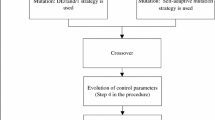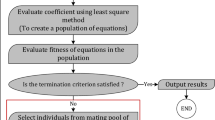Abstract
The depollution of some gaseous streams containing n-hexane is studied by adsorption in a fixed bed column, under dynamic conditions, using granular activated carbon and two types of non-functionalized hypercross-linked polymeric resins. In order to model the process, a new neuro-evolutionary approach is proposed. It is a combination of a modified differential evolution (DE) with neural networks (NNs) and two local search algorithms, the global and local optimizers, working together to determine the optimal NN model. The main elements that characterize the applied variant of DE consist in using an opposition-based learning initialization, a simple self-adaptive procedure for the control parameters, and a modified mutation principle based on the fitness function as a criterion for reorganization. The results obtained prove that the proposed algorithm is able to determine a good model of the considered process, its performance being better than those of an available phenomenological model.











Similar content being viewed by others
References
Ahmad AA, Hameed BH (2010) Fixed-bed adsorption of reactive azo dye onto granular activated carbon prepared from waste. J Hazard Mater 175:298–303
Brest, J. (2009). Constrained real-parameter optimization with e-self-adaptive differential evolution. In E. Mezura-Montes (Ed.), Constraint-handling in evolutionary optimization. Studies in Computational Intelligence Springer Berlin/Heidelberg, pp. 73-93.
Buburuzan AM, Catrinescu C, Macoveanu M (2009) Adsorption of n-hexane vapors onto non-functionalised hypercrosslinked polymers (hypersol-macronettm) and activated carbon: thermodynamic and kinetic studies. Environ Eng Manag J 8:259–265
Buburuzan AM, Catrinescu C, Macoveanu M (2010) Comparative study of the adsorption-desorption cycles of hexane over hypercrosslinked polymeric adsorbents and activated carbon. Environ Eng Manag J 9:125–132
Caicedo Torres W, Quintana M, Pinzon H (2013) Differential diagnosis of hemorrhagic fevers using ARTMAP and artificial immune system. Int J Artif Intell 11:150–169
Chandra A, Yao X (2006) Ensemble learning using multi-objective evolutionary algorithms. J Math Model Algoritm 5:417–445
Curteanu S, Cartwright H (2012) Neural networks applied in chemistry. I Determination of the optimal topology of multilayer perceptron neural networks J Chemom 25:527–549
Das S, Suganthan PN (2011) Differential evolution: a survey of the state-of-the-art. IEEE Trans Evol Comput 15:4–31
Dragoi EN, Curteanu S, Leon F, Galaction AI, Cascaval D (2011) Modeling of oxygen mass transfer in the presence of oxygen-vectors using neural networks developed by differential evolution algorithm. Eng Appl Artif Intell 24:1214–1226
Dragoi EN, Curteanu S, Lisa C (2012a) A neuro-evolutive technique applied for predicting the liquid crystalline property of some organic compounds. Eng Optim 44:1261–1277
Dragoi EN, Curteanu S, Fissore D (2012b) Freeze-drying modeling and monitoring using a new neuro-evolutive technique. Chem Eng Sci 72:195–204
Dragoi EN, Curteanu S, Galaction AI, Cascaval D (2013) Optimization methodology based on neural networks and self-adaptive differential evolution algorithm applied to an aerobic fermentation process. Appl Soft Comput 13:222–238
Feoktistov, V. (2006). Differential evolution: in search of solutions. Springer
Floreano D, Durr P, Mattiussi C (2008) Neuroevolution: from architectures to learning. Evol Intell 1:47–62
Furtuna R, Curteanu S, Leon F (2012) Multi-objective optimization of a stacked neural network using an evolutionary hyper-heuristic. Appl Soft Comput 12:133–144
Gupta VK, Verma N (2002) Removal of volatile organic compounds by cryogenic condensation followed by adsorption. Chem Eng Sci 57:2679–2696
Halteta Buburuzan MB, Catrinescu C, Macoveanu M (2009) Adsorption of n-hexane vapors onto non-functionalized hypercrosslinked polymers (hypersol-macronettm) and activated carbon: equilibrium studies. Environ Eng Manag J 8:173–181
Han L, Shi X, Wu W, Kirk FL, Luo J, Wang L et al (2005) Nanoparticle-structured sensing array materials and pattern recognition for VOC detection. Sens Actuators B: Chem 106:431–441
Hernandez RP, Alvarez-Gallegos J, Reyes J (1998) Simple recurrent neural network: a neural network structure for control systems. Neurocomput 3:277–289
Hu Q, Li JJ, Hao ZP, Li LD, Qiao SZ (2009) Dynamic adsorption of volatile organic compounds on organofunctionalized SBA-15 materials. Chem Eng J 149:281–288
Khan FI, Ghoshal A (2000) Removal of volatile organic compounds from polluted air. J Loss Prev Process Ind 13(6):527–545
Kim KJ, Kang CS, You YJ, Chung MC, Woo MW, Jeong WJ et al (2006) Adsorption-desorption characteristics of VOCs over impregnated activated carbons. Catal Today 111:223–228
Leeghim H, Seo IH, Bang H (2008) Adaptive nonlinear control using input normalized neural networks. J Mech Sci Technol 22:1073–1083
Lillo-Rodenas MA, Fletcher AJ, Thomas KM, Cazorla-Amoris D, Linares-Solano A (2006) Competitive adsorption of a benzene-toluene mixture on activated carbons at low concentration. Carbon 44:1455–1463
Llanos J, Rodrigo MA, Canizares P, Furtuna RP, Curteanu S (2013) Neuro-evolutionary modelling of the electrodeposition stage of a polymer-supported ultrafiltration-electrodeposition process for the recovery of heavy metals. Environ Model Softw 42:133–142
Matros YS, Noskov AS, Chumachenko VA, Goldman OV (1988) Theory and application of unsteady catalytic detoxication of effluent gases from sulfur dioxide, nitrogen oxides and organic compounds. Chem Eng Sci 43:2061–2066
Matthies M, Giupponi C, Ostendorf B (2007) Environmental decision support systems: current issues, methods and tools. Environ Model Softw 22:123–127
Neri F, Tirronen V (2010) Recent advances in differential evolution: a survey and experimental analysis. Artif Intell Rev 33:61–106
Odabasi M, Ongan O, Cetin E (2005) Quantitative analysis of volatile organic compounds (VOCs) in atmospheric particles. Atmospheric Environ 39:3763–3770
Pant M, Thangaraj R, Abraham A, Grosan C, Differential Evolution with Laplace mutation operator (2009) Proceedings of the Eleventh Conference on Congress on Evolutionary Computation, Trondheim. IEEE Press, Norway, pp 2841–2849
Patan K, Approximation Abilities of Locally Recurrent Networks (2008) Artificial neural networks for the modelling and fault diagnosis of technical processes. Lecture notes in control and information sciences. Springer Berlin, Heidelberg, pp 65–75
Peng L, Wang Y (2010) Differential evolution using uniform-quasi-opposition for initializing the population. Inf Technol J 9:1629–1634
Pirdashti M, Curteanu S, Kamangar MH, Hassim M, Amid M (2013) Artificial neural networks: applications in chemical engineering. Rev Chem Eng 29:205–239
Precup RE, Tomescu ML, Preitl S (2007) Lorenz system stabilization using fuzzy controllers. Int J Comput Commun Control 2:279–287
Shim WG, Lee JW, Moon H (2006) Adsorption equilibrium and column dynamics of VOCs on MCM-48 depending on pelletizing pressure. MicroporousMesoporous Mater 88:112–125
Silvestre-Albero A, Ramos-Fernandez JM, Martinez-Escandell M, Seplveda-Escribano A, Silvestre-Albero J, Rodriguez-Reinoso F (2010) High saturation capacity of activated carbons prepared from mesophase pitch in the removal of volatile organic compounds. Carbon 48:548–556
Srivastava AK (2003) Detection of volatile organic compounds (VOCs) using SnO2 gas-sensor array and artificial neural network. Sensors Actuators B Chem 96:24–37
Storn R, Differential Evolution Research - Trends and Open Questions. In U. Chakraborty (2008) Advances in differential evolution. Studies in computational intelligence. Springer Berlin, Heidelberg, pp 1–31
Subudhi B, Jena D (2009) An improved differential evolution trained neural network scheme for nonlinear system identification. Int J Autom Comput 6:137–144
Tchoupo GN, Guiseppi-Elie A (2005) On pattern recognition dependency of desorption heat, activation energy, and temperature of polymer-based VOC sensors for the electronic NOSE. Sensors Actuators B Chem 110:81–88
Tizhoosh HR (2005) Opposition-based learning: a new scheme for machine intelligence. In: In: International Conference on Computational Intelligence for Modeling, Control and International Conference on Intelligent Agents, Web technologies and Internet Commerce. 28-30 Nov 2005., pp 695–701
Vassileiou A, Maris F, Kitikidou K, Iliadis L (2012) Artificial neural networks for improved predictions in flow estimation. Int J Artif Intell 9:186–201
Xin Y (1999) Evolving artificial neural networks. Proc IEEE 87:1423–1447
Yoon YH, Nelson JH (1984) Application of gas adsorption kinetics. I. A theoretical model for respirator cartridge service life. Am Ind Hyg Assoc J 45:509–516
Zarth, A., & Ludermir, T. B. (2009). Optimization of neural networks weights and architecture: a multimodal methodology. In: Ninth International Conference on Intelligent Systems Design and Applications (ISDA’09) pp. 209-214.
Acknowledgments
This work was supported by the “Partnership in priority areas—PN-II” program, financed by ANCS, CNDI-UEFISCDI, project PN-II-PT-PCCA-2011-3.2-0732, No. 23/2012.
Author information
Authors and Affiliations
Corresponding author
Additional information
Responsible editor: Michael Matthies
Rights and permissions
About this article
Cite this article
Curteanu, S., Suditu, G.D., Buburuzan, A.M. et al. Neural networks and differential evolution algorithm applied for modelling the depollution process of some gaseous streams. Environ Sci Pollut Res 21, 12856–12867 (2014). https://doi.org/10.1007/s11356-014-3232-x
Received:
Accepted:
Published:
Issue Date:
DOI: https://doi.org/10.1007/s11356-014-3232-x




